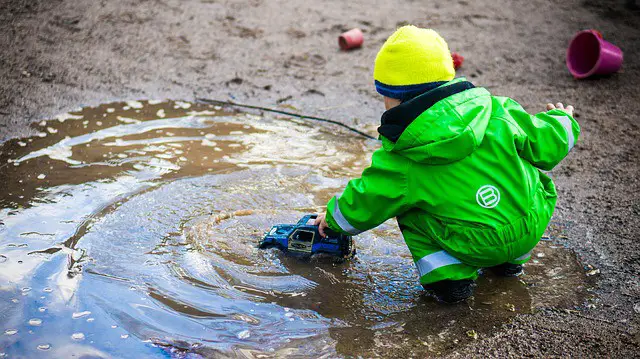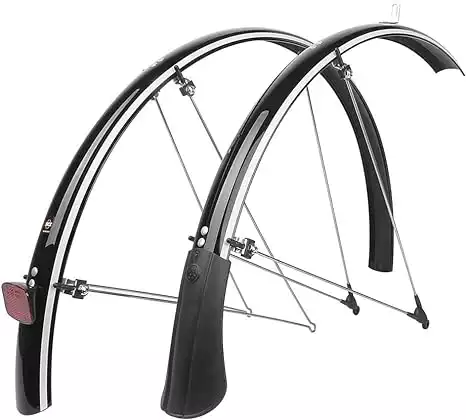If you aspire to be a year-round bike commuter it is inevitable to commute in the rain on certain days. This might seem too intimidating initially, so we’re going to see how to ride your bike work even on rainy days.
To make cycling to work in the rain possible you need to prepare your bike, get some commuter products specifically for rain and take some safety measures.
In this post we’re going to see:
- How to prepare your bike
- What to wear for the ride and what to do with your wet clothes
- How to carry your stuff in the rain
- What safety measures to take in the rain
Prepare your bike
The first thing you need to keep prepared is your bike. A good dedicated commuter bike is always ready for a rainy commute. Fenders (mudguards) help keep the water from splashing onto you.
Electric bikes built for everything and priced for everyone. Shop Rad Power Bikes, America's #1 electric bike brand. Get out. Go further. Ride Rad.
As a regular commuter, you should equip your bike with a set of front and rear fenders. Don’t worry! Contrary to popular belief, they don’t slow you down, and the benefit they offer is well worth it.
The SKS Bluemels stand out from other fenders because of their reflective sides.
Some fenders come with extra long flaps, which also keep the water from splashing onto the person coming behind you.
What to wear in the rain?
When it comes to choosing commuter products specifically for the rain, you need to start with your clothes first.
As for what to wear when it rains, there is no cookie cutter solution. What you should wear depends a great deal on the temperature, your commute and your personal preferences.
In warm weather
If you get changed to commute specific clothes for your ride, there is no need for any rain gear if the temperature is 70 degrees Fahrenheit (20 Celsius) or higher. A light spring or summer sprinkle will do no harm to you.

A rain jacket might keep your dry from the outside but it makes you sweat from the inside.
In a heavy downpour, a light rain jacket will offer some protection, but some water passes through after a while. If you commute in your work clothes and you want to keep yourself completely dry, a cycling specific rain poncho offers good protection.
The real problem with heavy rain is not so much the water from above, but rather the water splashing up from the road. To keep completely dry you need to prevent your legs and feet from getting wet.
Waterproof cycling overpants will keep your pants from getting wet, and some also offer built in shoe protection so your feet don’t get wet either. You can also use overshoes that keep your shoes dry.

If you don’t mind getting wet, riding in a summer downpour without any rain gear can be so much fun! If you wear a polyester sports top and shorts, they will dry really fast.
Here are some rain protection for warm rainy days:
Water resistant summer cycling jacket
Waterproof summer cycling jacket
Waterproof poncho
Waterproof overpants
In cold weather
When the temperature is cool or cold, you need to pay more attention to keeping dry, because you can get sick much more easily.
Riding wet is OK.
Riding in cold is OK.
Riding wet in cold is NOT OK.
The key to riding in the rain when the weather is cold lies in wearing multiple layers, with the outermost layer being waterproof.
A rain jacket is sufficient if it doesn’t rain too hard, but in heavy rain a cycling rain poncho offers the best protection.
On normal winter days I use a normal rainproof jacket (non cycling specific) to ride even on non-rainy days since it also acts as a wind-breaker and it also doubles as my rain jacket when necessary.
Meet silly me on a cold wet winter day:
You will also need something for your legs and feet that are 100% waterproof. Cycling overpants and overshoes can keep you completely dry.
Your helmet can also offer some protection from water, especially it it has no or just a few vents. By using a cycling cap you can also keep the water out of your eyes.
If you use an aerodynamic helmet with lots of vents, cycling caps made of merino wool can keep your head warm even in the rain.
You should also have some waterproof thermal gloves that protect your hands from the wind cold and rain. There are very few things that compare to the discomfort of frozen wet fingers when riding a bicycle. One of the best types of gloves for cycling in the cold rain is the split finger type (aka lobster gloves). They keep your fingers together in pairs so they can warm each other while keeping out the water.
Here are some great products for cycling in the winter:
Winter thermal rain jersey
Winter pants
Waterproof overpants
Winter shoe covers
Gloves
Merino wool cycling cap
What to do with wet clothes?
If you did a good job and you were able to keep dry under your rain gear, you just need to find a place for the jacket and the pants to dry, just like your colleagues, who have to deal with their wet jackets, ponchos and umbrellas.
If you got wet despite your best efforts, you need to look for a way to dry your clothes. One of the worst feelings is to put on wet clothes on a cold day.
You can use a locker if you have one, a hanger near a heat source or the back of a chair that isn’t used. You can also get creative and talk to your employer. For example, in our office building the heating control room is not used by anyone, and I hang my clothes to dry there if I need to.
If you need some extra boost to make your clothes dry faster, you can check out this clever portable dryer, which has a built in warm air vent and can dry your shoes, clothes or whatever you hang on it much faster than a normal hanger. You can keep it in the office and use it whenever necessary.
Whether you cycle to work in your work clothes or get changed for the commute and carry your work clothes with you, you should always keep a set of change of clothes at work. This way you will never be left without dry clothes.
Personally, I keep several sets of clothes at the office, and I get changed for the commute, so I never have to deal with the problem of wet clothes for work. Even if I get wet during the ride, my clothes dry completely while I’m working.
How to carry stuff in the rain?
If you’re not among those privileged who never have to carry anything to work, you need to think of how you’re going to keep your belongings dry. The more valuable and the less water resistant these are, the more important it is to protect them.
Some panniers and backpacks offer full waterproofing either because they’re made of a waterproof material or because they come with a waterproof cover that you can place on them. Pay attention to the seams and worn out parts where water can seep through.
If you’re a year round commuter in all weather conditions, it makes a lot of sense to invest into a fully waterproof pannier, backpack or messenger bag depending on your commute and personal preference. It will give you the peace of mind that all your electronic devices are safe and will not be damaged even if you get caught in an unexpected sudden shower.
I use a Decathlon pannier for bike commuting and it has worked fine for nearly two years, although it has started showing signs of wear, which may soon lead to loss of waterproofing.
If you are looking for the best waterproof pannier look for Ortlieb panniers. They are expensive but incredibly durable. Some bike commuters have used the same Ortlieb pannier for more than a decade and never had a single problem with it.
Here are some solid recommendations to carry your stuff in:
Waterproof pannier
Waterproof cycling backpack
Waterproof messenger bag
Waterproof cover for a backpack
What safety measures to take in the rain?
There are two important things to keep in mind when riding in the rain:
1. reduced visibility and
2. different riding conditions than on dry roads.
Visibility
Poor visibility means that it’s harder to spot people, vehicles and hazards and to react to them. This is true for everyone: pedestrians, drivers, other cyclists and also for you.
On one hand you need to make sure that you are as visible as possible to make it easy for others to spot you, and on the other, you have to pay special attention, because unfortunately not everyone takes visibility precautions.
Lights
Having a decent front and rear light is a must when riding in the rain. This is the number one way you can stay visible and safe.
Some lights will only serve you ‘to be seen’, while others are ‘to see with’ lights. In my experience, it’s always better to use ‘to see with’ lights, because you have the option of dimming it if the extra power isn’t necessary. However, in the rain, some ‘to be seen’ lights prove to be too weak.
One important feature you should look for when buying lights is water resistance. Some cheap lights may work OK for some time, but fail you when riding rain. Reputable brands make sure that the lights they make withstand rain, snow and other extreme weather conditions.
My Cateye Volt 800 lights have served me well despite being used in heavy downpours (check it on Amazon here). It provides me with enough light both to be seen with and to see, and it allows me to ride with confidence. The Cateye Rapid X3 is also an excellent choice for a rear light (check it on Amazon here).
Clothing
It is almost impossible to spot a cyclist wearing black pants and jacket without any reflective details before it’s too late, especially at night.
Cycling specific rain gear usually comes with reflectives, but if you wear other rain gear, think of putting on some reflective tape on it or wearing a hi vis reflective vest (like this cool looking one on Amazon).
Glasses
Riding in heavy rain does become uncomfortable to the eyes because the raindrops cut into them and can cause a lot of pain.
Glasses prevent raindrops from falling into your eyes.
There is a trade-off though, because raindrops stick to the glasses, which makes it harder to see through them. I used to wear glasses, but nowadays I just ride slower and tilt my head down slightly more.
Riding safely
Puddles, potholes, ponds
Riding in the rain requires more foresight. You need to avoid puddles at all costs.
When you see water on the ground, you don’t know what’s beneath it. It can be a very shallow puddle or a deep pothole, which may damage your bike or even cause you to fall.

Less traction
Your tires have less grip on wet ground, which increases your braking distance and your chances of falling. The more you scan the road ahead of you the less likely it is that you need to come to a sudden full stop.
You cannot maneuver and take turns with your bike at the same speed as you do on a dry, sunny day.
In a special way there are two surfaces that become really slippery when wet: white paint on the road and streets covered in cobblestones. It’s very easy to lose control of the bike when you suddenly brake or change direction on them, so ride on them with extreme caution.
The danger is not only in your tires slipping on the ground though. Your brakes also behave differently than in dry weather. Brake calipers first need to cut through a layer of water to clear off your rims before they can squeeze the rim with all their force. The superior braking power of disc brakes becomes obvious in rain.
Give more time to yourself!
While it’s not difficult to ride in the rain, it requires some preparation and precaution, which make your commutes slower on these days. On a dry, sunny, Summer day you can get ready for your commute within a few minutes, but on a cold, wet Winter day, the preparation takes much longer.
On rainy days allow some extra time in the morning so you don’t end up pushing too hard and end up having an accident. Even if you’re running late, don’t sacrifice your safety. It’s better to be late than dead.
Bonus tip #1: Saddle covers
Most saddles don’t mind the rain, and the water can be wiped off them easily. However, some saddles are made of leather or other delicate materials that don’t like being exposed to rain.
Depending what your saddle is made of, you may want to keep your saddle covered while you’re working so as to prevent it from being damaged.
Also, some saddles can absorb some moisture, which makes them very unpleasant to sit on when wet.
Saddle covers come in very handy in these cases.
Bonus tip #2: Lubing your chain
Rain takes a toll on your chain more than on any other part of your bike. If the roads are dirty or salt is used on the road in the winter, your chain can start to rust if not cleaned and lubed regularly. A rusty chain, dirty and rusty derailleurs and sprockets lead to imprecise shifting and strange noises.
Clean and lube your chain and drivetrain weekly to get the most out of it both in mileage and in riding experience. Pay attention that some lubes are designed for wet weather. They withstand rain much better. Thinner lubes wash off very easily. One of the best lubes for wet conditions is the WD40 wet chain lube (check price and availability on Amazon).
Conclusion
What’s the best way to cycle to work on a rainy day? Preparing yourself properly is half the battle. The other half depends on guts and determination. It definitely helps you form your character, and win some kudos from your friends. I hope that these tips will serve you as a guideline to prepare yourself and your bike to enjoy the rainy rides too in complete safety!
Happy riding!

